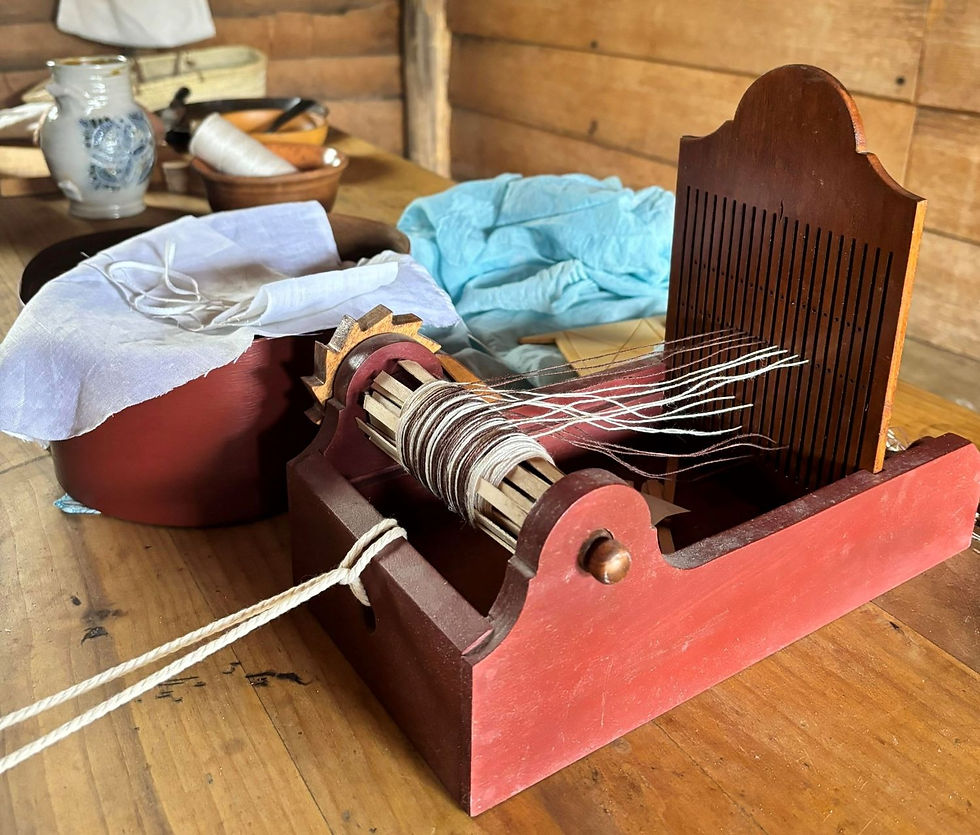Natural dyes, spinning wheels, and tape looms.
Recently, living history interpreters demonstrated how they spin, dye, and weave their way through the transformation of fibers into fabrics at Historic London Town and Gardens. In case you missed it, we wanted to share the wonderful information they provided while on site.

Outside the reconstructed Tenement house, we had three types of dye being used to make a rainbow of colors on various fabrics. First, madder plant roots were boiled in a large cauldron over a low burning fire. Madder plants are native to the Middle East and Northern Africa, but can be easily grown in the Mid Atlantic. Natural fibers, such as wool and linen, were steeped in the cauldron to create various shades of red. A combination of additives or extra dyes could be used to get colors like peachy-mauve, pink, or even dark purple.
Another cauldron was filled with yellow dye made from Osage Orange. Osage Orange is a native plant to North America. It was so popular that in the colonial period, the dye and the dyed fabric were being exported from the colonies back to Europe.
The third pot was filled with a dye made from the Indigofera plant, otherwise known as “indigo”. Indigo was sourced from tropical regions in the colonial period. Dying with indigo is intriguing: the fabric doesn’t turn blue until it is exposed to oxygen. When the fabric is first removed from the dye pot, it looks yellow but rapidly changes color to blue. To get a very dark blue, the fabric needs to be repeatedly dipped in the dye bath and exposed to oxygen.

Inside the Tenement building, our living history volunteer was seated at the table and showed how to operate a Tape Loom. In the 18th Century, this type of loom was used to weave narrow bands of cloth – called “tapes.” Tapes were used for straps, trim, ties, etc… Women in the 18th century used tapes for a multitude of reasons. For example, the thin tapes of fabric were used to close their aprons, tie on their petticoats, and to hold little things at their waist so they could access them easily. To operate the Tape Loom which is the size of a small toaster oven, she demonstrated how she passed the shuttle through the thread (called the shed), creating a basic checkered design (check out this Instagram video!).

Inside the historic William Brown House, our living history volunteer demonstrated how to use a type of spinning wheel called a Castle Wheel. During the afternoon, she pedaled the Castle Wheel to twist her yarn onto a bobbin. She estimated one full bobbin would take a person approximately four hours to fill.
Thank you to all of our living history interpreters who volunteered their time to demonstrate the fiber arts to all of our visitors. If you would like to see more demonstrations like this, we hope to have them on display during our Women’s Work Weekend in August and again in the Fall. If you would like to receive updates on upcoming events, please sign-up for our eblast: HERE.
Thinking about a UK Post-Study Work Visa? Zealand Immigration is here to help! Our experts guide you through the application process smoothly. We understand the requirements and work to boost your chances of success. Choose Zealand Immigration for a hassle-free experience and take the next step toward a bright future in the UK!
A Mens Leather Biker Jacket is a staple for every rider and fashion enthusiast. It’s tough, stylish, and built for adventure. At Biker Jacket, we make sure every jacket is crafted with premium materials for durability and comfort.
Stickman Hook offers tons of content to keep players engaged! There are loads of levels with escalating difficulty, each with distinct challenges like moving obstacles, speed ramps, and tricky jumps.
Looking for the ultimate style statement? The Jacket 8 Ball from Leather Moto is here to steal the show. Made for trendsetters, this piece combines bold design with high-quality craftsmanship. A jacket that speaks louder than words!
I had the pleasure of visiting Historic London Town & Gardens, and it was the perfect spot to enjoy the beauty of nature, especially while wearing my Mens Yellowstone Jacket from Western Apparel stylish and cozy for exploring!